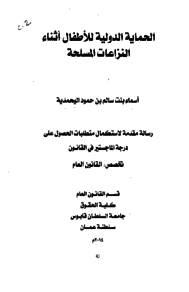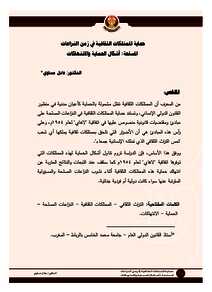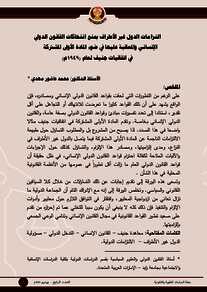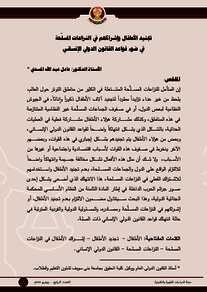Document
الحماية الدولية للأطفال أثناء النازعات المسلحة
Publisher
Sultan Qaboos University
Gregorian
2014
Language
Arabic
English abstract
The purpose of this thesis is to reach what is intentioned of the child who can Take full advantage of the protection rules which are prescribed by the conventions of International humanitarian law and the International law of Human Rights in armed conflicts, and discuss those conventions by studying the mandatory rules of the parties in international & non-international armed conflicts, as well as cognition of the efforts of the international community in reducing the phenomenon of recruitment and engaging children in armed conflicts, on the other hand highlighting the role of the International Criminal Court in restricting of the gross violations of the prescribed protections for children in armed conflicts via answering the following questions:
1. Who is the person who is considered a child in accordance to International Humanitarian Law?
2. What are the international conventions on children 'protection in armed conflicts?
3. What are the utmost efforts of the international community to reduce the number of victims of the armed conflicts from children?
4. What is the utmost degree of the International Criminal Court contribution in developing the rules of international law on children' protection during armed conflicts, and whether it has exercised its jurisdiction on the crimes related in this regard?
For answering the above queries we have been discussed a number of topics relating to the protection of children during armed conflicts, and our research divided into three chapters. The introductory chapter handled the historical development of the protection of children during armed conflicts through the ages, as well as the prescribed protection for children in the monotheistic religions, as the first chapter handled the aspects of general protection of children during armed conflicts, then the second object of the research discussed the special protection 'aspects for this fragile category and the reasons for taking decisions for their special protection. The second chapter handled children 'protection from the risk of recruitment and their engaging in armed forces' processes, and the meaning of what is meant by this principle and the responsibility of States who violated this obligation, as well as the international criminal responsibility of individuals. The research displayed some of the issues which dealt by the International Criminal Court in violation the principle, and the risks results via recruitment and involvement of children in hostilities. The research concluded a number of results through the study of this topic as follows:
1.International and non-International armed conflicts has been going on
for centuries, but the brutality of today's conflicts and the power of military arsenals are what motivated the international community to strengthen legal frameworks that provide legal protection for children as they represent a large segment of war-affected and victims as a result of wars.
2.Differentiation' principle between combatants and non-combatants comes at the forefront of the principles governing armed conflicts between parties. This principle applied that parties of the conflict shall at all times differentiate between people who are engaged in hostilities directly, and among those who not involved in such hostilities, in pursuit of them as much as possible to spare civilians the scourge of war and to protect them from the effects of armed conflict.
3. Children, according to their civil attributes, and because they are not taking part in hostilities, they obtained general protection such as that enjoyed by the rest of the civilian population, which is particularly protection against the excesses of hostile parties to international conventions and practices of war.
4.Children take satisfaction with the special protection guaranteed by the provisions of International Humanitarian Law as well as the International Law of Human Rights. Among the aspects of the special guaranteed protections for the rights of children is providing the emergency relief to them, and offering them family reunion to whom separated as a result of the armed conflict, moreover the inadmissibility of the implementation of sentencing for death for children under the age of eighteen years or issuing any judgment for this punishment, in addition to other forms of protection.
5 .Children are still subject to recruitment by the National Armed Forces in the event of international and non-international conflicts, and their recruitment by armed groups becomes a serious humanitarian problem. Statistics has revealed from the International Labor Organization in 2002 that about 300.000 children at least working as soldiers in organizations and armed groups, and participating in combat operations department in more than 41 countries in the world.
6. The Security Council is considered the executive organ of the United Nations, and has taken a number of decisions regarding children and armed conflicts. The Security Council considered that the recruitment and involvement of children in hostilities is a clear violation of the rules of international humanitarian law, and the rules of international law of human rights, and considered it - without a doubt - the responsibility of the state and whoever support in violation of such commitments.
7 .Judgment of condemnation issued by the International Criminal Court against Thomas Lubanga Dyilo for sentenced him imprisonment for fourteen-year-is consider a historical judgment for the International Criminal Court in terms of children' recruitment or using them in hostilities.
Description
رسالة جامعية
Member of
Resource URL
Arabic abstract
تهدف هذه الرسالة إلى التوصل إلى المقصود بالطفل الذي يستفيد من قواعد الحمايةالتي تقررها اتفاقيات القانون الدولي الإنساني والقانون الدولي لحقوق الانسان أثناء النزاعات المسلحة، والتطرق أيضا إلى تلك الاتفاقيات ودراسة القواعد الإلزامية للأطراف في النزاعات المسلحة الدولية وغير الدولية، وكذلك معرفة الجهود المبذولة من المجتمع الدولي في الحد من ظاهرة تجنيد واشتراك الأطفال في النزاعات المسلحة، وأيضا إبراز دور المحكمة الجنائية الدولية في الحد من الانتهاكات الجسيمة لصور الحماية المقررة للأطفال أثناء النزاعات المسلحة، وذلك من خلال الإجابة على التساؤلات التالية:
1- من هو الشخص الذي يعد طفلا وفقا للقانون الدولي الإنساني؟
۲- ما هي المواثيق الدولية المعنية بحماية الأطفال أثناء النزاعات المسلحة؟
٣- ما هي الجهود التي بذلها المجتمع الدولي لتقليل عدد ضحايا النزاعات المسلحة من الأطفال؟
4- ما مدى مساهمة المحكمة الجنائية الدولية في تطوير قواعد القانون الدولي الخاصة بحماية الأطفال أثناء النزاعات المسلحة، وهل مارست اختصاصها بنظر الجرائم المتعلقة في هذا الشأن؟
وللإجابة على هذه التساؤلات تم بحث عدد من المواضيع المتعلقة بحماية الأطفال أثناء النزاعات المسلحة، وقسم إلى ثلاثة فصول، حيث تناول الفصل التمهيدي التطور التاريخي لحماية الأطفال أثناء النزاعات المسلحة عبر العصور المختلفة، وكذلك الحماية المقررة للأطفال في الديانات السماوية، أما الفصل الأول فتناول صور الحماية العامة للأطفال أثناء النزاعات المسلحة، ثم تطرق إلى صور الحماية الخاصة لهذه الفئة الهشة وأسباب تقرير حماية خاصة لهم، أما الفصل الثاني فتناول حماية الأطفال من خطر التجنيد والاشتراك في العمليات المسلحة وبين المقصود بهذا المبدأ ومسؤولية الدول المنتهكة لهذا الالتزام وكذلك المسؤولية الجنائية الدولية للأفراد، وعرض البحث بعض القضايا التي نظرتها المحكمة الجنائية الدولية في انتهاك مبدأ حظر تجنيد وإشراك الأطفال في العمليات العدائية، وخلص البحث إلى عدد من النتائج من خلال دراسة هذا الموضوع:
١- إن النزاعات المسلحة الدولية وغير الدولية مستمرة منذ قرون مضت، إلا أن وحشية الصراعات اليوم وقوة الترسانات العسكرية هي ما دفعت بالمجتمع الدولي إلى تعزيز الأطر القانونية التي توفر الحماية القانونية للأطفال باعتبار أنهم يمثلون الشريحة الكبيرة من المتضررين والضحايا من
جراء الحروب.
۲- يأتي مبدأ التفرقة بين المقاتلين وغير المقاتلين في مقدمة المبادئ التي تحكم النزاعات المسلحة بين الأطراف ويقضي هذا المبدأ بأنه على أطراف النزاع في جميع الأوقات ضرورة التمييز بين الأشخاص الذين يشتركون في العمليات العدائية بصورة مباشرة وبين أولئك الذين لا يشتركون فيها،
سعيا منهم بقدر الإمكان لتجنيب المدنيين ويلات الحروب وحمايتهم من آثار النزاع المسلح.
3- يحظى الأطفال وفقا لصفتهم المدنية ولكونهم لا يشتركون في الأعمال العدائية بحماية عامة كتلك التي يتمتع بها باقي السكان المدنيين والتي تتمثل بصفة خاصة في الحماية ضد تجاوزات الأطراف المعادية للاتفاقيات الدولية وأعراف الحرب.
4- يتمتع الأطفال بحماية خاصة تكفلها أحكام القانون الدولي الإنساني وكذلك القانون الدولي لحقوق الإنسان، ومن صور الحماية الخاصة المكفولة للأطفال تقديم الإغاثة العاجلة لهم، وجمع شملهم بأسرهم التي تشتت نتيجة للنزاع المسلح، وعدم جواز تنفيذ عقوبة الإعدام للأطفال الذين يقل سنهم
عن ثمانية عشرة سنة أو إصدار حكم بهذه العقوبة وغيرها من صور الحماية
5- لا يزال الأطفال يخضعون للتجنيد على يد القوات الوطنية المسلحة في حال نشوب نزاعات دولية وغير دولية كما وأضحى تجنيدهم من قبل الجماعات المسلحة مشكلة إنسانية خطيرة، وقد كشفت الإحصائيات الصادرة عن منظمة العمل الدولية في عام ۲۰۰۲ أن نحو (۳۰۰) ألف طفل على الأقل يعملون كجنود في المنظمات والجماعات المسلحة ويشاركون في العمليات القتالية الدائرة في أكثر من (41) دولة في العالم. - يعد مجلس الأمن الجهاز التنفيذي للأمم المتحدة وقد اتخذ عدد من القرارات في شأن الأطفال والنزاعات المسلحة، فاعتبر أن تجنيد الأطفال وإشراكهم في العمليات العدائية يمثل انتهاكا ص ريحا القواعد القانون الدولي الإنساني وقواعد القانون الدولي لحقوق الإنسان والتي تقوم معها - بلا شك - مسؤولية الدولة المنتهكة لمثل هذه الالتزامات. ۷- يعد حكم المحكمة الجنائية الدولية ضد "توماس لويانغا ديلو" والمحكوم عليه بالسجن لمدة أربعة عشر عاما حكما تاريخيا يحسب للمحكمة الجنائية الدولية بشأن تجنيد الأطفال أو اشراكهم في العمليات الحربية.
1- من هو الشخص الذي يعد طفلا وفقا للقانون الدولي الإنساني؟
۲- ما هي المواثيق الدولية المعنية بحماية الأطفال أثناء النزاعات المسلحة؟
٣- ما هي الجهود التي بذلها المجتمع الدولي لتقليل عدد ضحايا النزاعات المسلحة من الأطفال؟
4- ما مدى مساهمة المحكمة الجنائية الدولية في تطوير قواعد القانون الدولي الخاصة بحماية الأطفال أثناء النزاعات المسلحة، وهل مارست اختصاصها بنظر الجرائم المتعلقة في هذا الشأن؟
وللإجابة على هذه التساؤلات تم بحث عدد من المواضيع المتعلقة بحماية الأطفال أثناء النزاعات المسلحة، وقسم إلى ثلاثة فصول، حيث تناول الفصل التمهيدي التطور التاريخي لحماية الأطفال أثناء النزاعات المسلحة عبر العصور المختلفة، وكذلك الحماية المقررة للأطفال في الديانات السماوية، أما الفصل الأول فتناول صور الحماية العامة للأطفال أثناء النزاعات المسلحة، ثم تطرق إلى صور الحماية الخاصة لهذه الفئة الهشة وأسباب تقرير حماية خاصة لهم، أما الفصل الثاني فتناول حماية الأطفال من خطر التجنيد والاشتراك في العمليات المسلحة وبين المقصود بهذا المبدأ ومسؤولية الدول المنتهكة لهذا الالتزام وكذلك المسؤولية الجنائية الدولية للأفراد، وعرض البحث بعض القضايا التي نظرتها المحكمة الجنائية الدولية في انتهاك مبدأ حظر تجنيد وإشراك الأطفال في العمليات العدائية، وخلص البحث إلى عدد من النتائج من خلال دراسة هذا الموضوع:
١- إن النزاعات المسلحة الدولية وغير الدولية مستمرة منذ قرون مضت، إلا أن وحشية الصراعات اليوم وقوة الترسانات العسكرية هي ما دفعت بالمجتمع الدولي إلى تعزيز الأطر القانونية التي توفر الحماية القانونية للأطفال باعتبار أنهم يمثلون الشريحة الكبيرة من المتضررين والضحايا من
جراء الحروب.
۲- يأتي مبدأ التفرقة بين المقاتلين وغير المقاتلين في مقدمة المبادئ التي تحكم النزاعات المسلحة بين الأطراف ويقضي هذا المبدأ بأنه على أطراف النزاع في جميع الأوقات ضرورة التمييز بين الأشخاص الذين يشتركون في العمليات العدائية بصورة مباشرة وبين أولئك الذين لا يشتركون فيها،
سعيا منهم بقدر الإمكان لتجنيب المدنيين ويلات الحروب وحمايتهم من آثار النزاع المسلح.
3- يحظى الأطفال وفقا لصفتهم المدنية ولكونهم لا يشتركون في الأعمال العدائية بحماية عامة كتلك التي يتمتع بها باقي السكان المدنيين والتي تتمثل بصفة خاصة في الحماية ضد تجاوزات الأطراف المعادية للاتفاقيات الدولية وأعراف الحرب.
4- يتمتع الأطفال بحماية خاصة تكفلها أحكام القانون الدولي الإنساني وكذلك القانون الدولي لحقوق الإنسان، ومن صور الحماية الخاصة المكفولة للأطفال تقديم الإغاثة العاجلة لهم، وجمع شملهم بأسرهم التي تشتت نتيجة للنزاع المسلح، وعدم جواز تنفيذ عقوبة الإعدام للأطفال الذين يقل سنهم
عن ثمانية عشرة سنة أو إصدار حكم بهذه العقوبة وغيرها من صور الحماية
5- لا يزال الأطفال يخضعون للتجنيد على يد القوات الوطنية المسلحة في حال نشوب نزاعات دولية وغير دولية كما وأضحى تجنيدهم من قبل الجماعات المسلحة مشكلة إنسانية خطيرة، وقد كشفت الإحصائيات الصادرة عن منظمة العمل الدولية في عام ۲۰۰۲ أن نحو (۳۰۰) ألف طفل على الأقل يعملون كجنود في المنظمات والجماعات المسلحة ويشاركون في العمليات القتالية الدائرة في أكثر من (41) دولة في العالم. - يعد مجلس الأمن الجهاز التنفيذي للأمم المتحدة وقد اتخذ عدد من القرارات في شأن الأطفال والنزاعات المسلحة، فاعتبر أن تجنيد الأطفال وإشراكهم في العمليات العدائية يمثل انتهاكا ص ريحا القواعد القانون الدولي الإنساني وقواعد القانون الدولي لحقوق الإنسان والتي تقوم معها - بلا شك - مسؤولية الدولة المنتهكة لمثل هذه الالتزامات. ۷- يعد حكم المحكمة الجنائية الدولية ضد "توماس لويانغا ديلو" والمحكوم عليه بالسجن لمدة أربعة عشر عاما حكما تاريخيا يحسب للمحكمة الجنائية الدولية بشأن تجنيد الأطفال أو اشراكهم في العمليات الحربية.
Category
Theses and Dissertations






